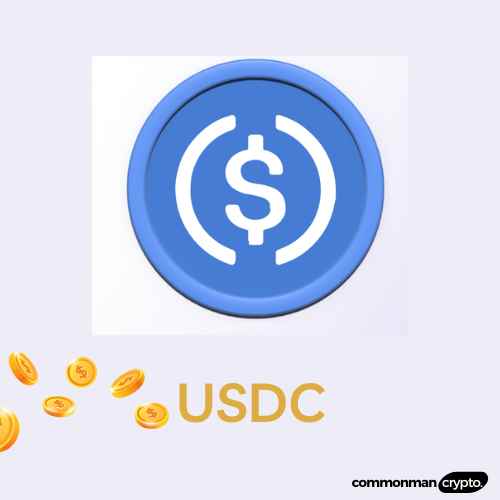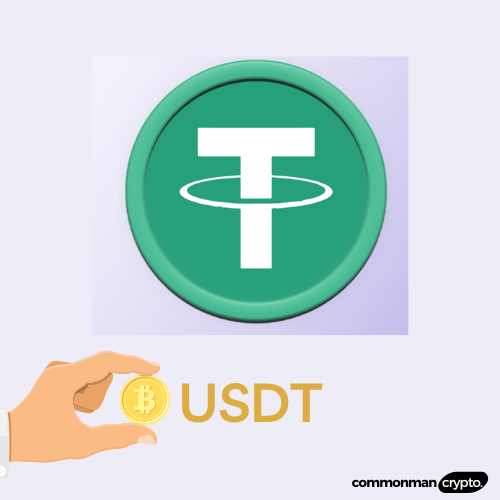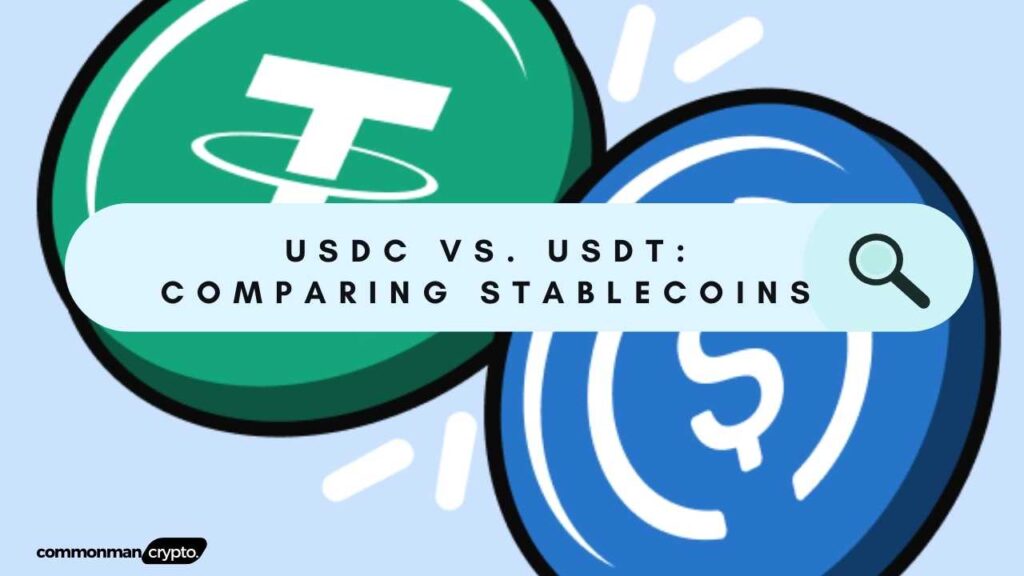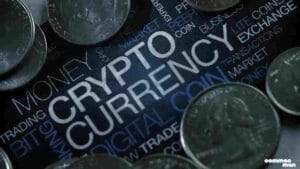To gain more insight into them, we will examine two of the most popular fiat-backed stablecoins, Tether USDT vs. USDC, respectively, in detail in this article. The cryptocurrency world is full of tokens that have fixed values tied to dollars or fiat currency – these tokens are commonly known as stablecoins. Tether USDT and USDC. This comparison article will also focus on their features, similarities, potential downsides vs upsides for each coin, and more.
But first, here’s a brief run-down on the basics.
What Are Stablecoins, and How Do They Work?
Stablecoins are low-volatility or stable crypto assets backed by real-world assets like fiat currency (the U.S. dollar). There are various stablecoins with various mechanisms – algorithmic, fiat-based, commodity-backed, or crypto-backed. Stablecoins solve price fluctuations seen with mainstream cryptocurrency tokens like Bitcoin (BTC), making investment less practical for everyday transactions.
Fiat-backed stablecoins typically maintain reserves in fiat currencies like the U.S. dollar, guaranteeing one dollar in reserve per token in circulation – either cash or cash equivalents. Central entities oversee these funds regularly through audits conducted with regulatory authorities to ensure compliance. Individuals wishing to buy directly from creators must go through Know Your Customer (KYC) and Anti-Money Laundering (AML) verification processes similar to what crypto exchanges conduct; these include collecting personal information such as copies of government-issued identification as part of these verification procedures.
Once in circulation, stablecoins can be freely sent and received by anyone. However, their central entity of issue may possess the power to freeze funds at specific addresses – this authority has been exercised before when issuers cooperated with law enforcement for investigations or attempted to recover stolen funds, among other reasons.
What Is USDC (USD Coin)?
USDC stands for “USD Coin,” a form of cryptocurrency known as a stablecoin. USDC is currently the Seventh-largest crypto by market cap at approximately $29B billion as reported by CoinMarketCap data as on March 2024. Stablecoins are designed to maintain their value over time by being pegged to tangible assets such as traditional fiat currencies like the U.S. dollar; USDC specifically is pegged 1:1 against it, meaning one USDC token should always equal one U.S. dollar.
While Tether was widely adopted, its U.S. dollar reserves and management were under fire, leading to several USD pegged stablecoins with transparent auditing, funding, and regulation mechanisms – one being USD Coin or USDC.
Circle first launched USDC as an ERC-20 token on Ethereum before expanding it across other blockchains, such as Solana and Algorand. USDC coins do not produce themselves through mining but through smart contracts; when someone deposits fiat U.S. Dollars through a Smart Contract, a USDC token is generated in response. When someone redeems these dollars back from Smart Contract, their supply, and volatility remain intact by the permanent destruction of USDC tokens.

Key Features of USDC
- Stability: USDC was designed to maintain a steady value, making it suitable for various financial transactions like trading on crypto exchanges or simply transferring value without experiencing price volatility like Bitcoin or Ethereum.
- Transparency: USDC issuers, which include regulated financial institutions, must hold an equal amount in reserves to back circulating tokens of USDC. Regular audits and transparency reports ensure that real assets fully support tokens.
- Use Cases: USDC has many uses within the cryptocurrency ecosystem, from serving as a reliable store of value, trading against other cryptocurrencies, remittance services, and even decentralized finance (DeFi) applications.
- Regulation: USDC is typically issued and managed by financial institutions under existing regulatory frameworks, thus helping reduce regulatory concerns compared to other cryptos.
- Ethereum-Based: USDC was initially released as an ERC-20 token on Ethereum but has since expanded onto other blockchain networks like Algorand and Stellar.
You may also like :
What are Bitcoin ATMs? How Do Bitcoin ATMs Work? Where Can I Find Them? (2024)
What Is Bitcoin Spark? (2024)
What Are Bitcoin Puppets? & Where Can You Buy Them? (2024)
What Is USDT (USDT)?
Tether USDT is currently the third-largest crypto by market cap at approximately $104B billion as reported by CoinMarketCap data as on March 2024 and first introduced on Omni Blockchain (a protocol layer of Bitcoin network) by Hong-Kong based Tether Ltd in July 2014, offering users an asset with liquidity and transparency similar to cryptos like Bitcoin or Ethereum but with stability similar to traditional fiat. Supported across multiple blockchain networks and pegged 1:1 to the US Dollar therefore, every coin circulating in the market requires Tether Ltd to maintain an asset reserve equal to or greater than its total value to maintain price stability for that coin circulating on the market exchange.
USDT is often utilized in the crypto space as a safe haven to move funds between volatile coins while maintaining relatively stable values. For example, an investor might convert some or all of their Bitcoin holdings to USDT during market downturns to protect themselves from losses and then convert back when ready to reinvest into the cryptocurrency market.
USDT has been subject to several controversies regarding its decentralization and reserve management level. Tether and Bitfinex were caught up in allegations regarding funding, leading them to pay an $18.5 million penalty upon investigation by the New York Attorney General (NYAG). Following these criticisms, Tether Ltd now discloses its cash reserve in monthly reports to enhance transparency for USDT coin users.

Key Features of USDT
- Price Stability of USDT: It is designed to maintain a stable value, typically pegged at one United States Dollar (USD). This makes USDT a valuable way for traders to temporarily exit volatile crypto markets without converting their holdings into fiat currency.
- Liquidity: USDT is one of the most liquid cryptos, widely accepted on various crypto exchanges and trading platforms. This makes buying, selling, or exchanging USDT for other cryptocurrencies or fiat currency effortless for its users.
- Transparency: Tether Limited, the company behind USDT tokens, claims that its reserves are regularly audited so as to guarantee there is a 1:1 match between USDT tokens and real-world assets, like USD, as backed up with real-time auditing frequency. Nonetheless, many members of the cryptocurrency community remain concerned over Tether’s transparency level and audit frequency.
- Accessibility: USDT can be easily accessed and utilized by anyone with an internet connection and crypto wallet, and it is available on many cryptocurrency exchanges globally for trading or transfer.
- Transfer Speed: Transferring USDT between wallets or exchanges can often be faster and more efficient than bank transfers, making this an attractive choice for international transactions and remittances.
- Risk Management: USDT offers traders and investors a way to protect themselves against crypto market volatility by diversifying into it during periods of uncertain market conditions, protecting their capital against significant price changes.
Key Similarities: USDT vs. USDC
Stable Value: USDT and USDC tokens are stablecoins tied directly to US Dollar fiat currency, eliminating price volatility associated with cryptocurrencies like Bitcoin or Ethereum.
Fast Transaction Speeds: USDT and USDC transactions can be processed faster than traditional payment methods; funds can be moved instantly via internet connectivity.
Low Transaction Cost:USDT and USDC as stablecoins offer transactions at a significantly reduced cost compared to the high gas fees associated with other crypto assets and traditional finance tools like credit cards.
Accessibility and Liquidity: Most crypto exchanges, wallets, and DeFi protocols support USDC and USDT stablecoin with various trading pairs to maximize liquidity and trading volume.
Ethereum Compatible: USDC coin and USDT are based on ERC-20 tokens and support various applications, smart contracts, and protocols within the Ethereum blockchain ecosystem.

Key Differences: USDT vs. USDC
- Reserve Management: Tether Ltd manages its USDT asset reserves while Circle holds them under custody at top financial institutions such as BNY Mellon and BlackRock.
- Audit: The Deloitte accounting firm audits USDC coin assets regularly, and its monthly attestation report is published on the Circle USDC website. In contrast, USDT does not publish asset reserve reports but instead only has asset auditing information publicly available.
- Global Adoption: While both USDT and USDC are well-established stablecoins in the crypto market, Tether USDT’s market cap currently stands at an astounding $104 billion compared to just $29 billion for USDC coins as of March 9, 2023.
- Divisibility: Circle USDC can be divided into units like any fiat currency such as U.S. dollars; however, Tether USDT cannot be divided, restricting its functionalities.
- Transparency: Tether USDT has been subject to considerable discussion and scrutiny about its open working model, while USDC consistently ensures public trust by conducting audits and issuing reverse reports on an annual basis.
Stablecoin Risks
Stablecoins (including popular ones like USDT (Tether), USDC (USD Coin), and other such stablecoins) offer greater stability compared to highly volatile cryptos like Bitcoin and Ethereum; however, they still carry risks that should be taken into consideration before investing. Below are some critical risks associated with stablecoins:
- Regulations: Evolving regulations may impact issuance and use.
- Counterparty Risk: Issuers must trust each other to hold the assets necessary for token issuance and use.
- Transparency Risks: Varying levels of transparency regarding reserve asset reporting can create issues.
- Centralization Issues: Overreliance on one issuer could create complications.
- Technology: Vulnerabilities in blockchain and smart contracts. Lugging market liquidity may impact
- Price stability: Users must trust the issuer’s responsibility and stability. Unexpected market events can threaten the equilibrium.
- Market Risk: Supply and demand fluctuations can wreak havoc with market stability.
- Redemption: Delays or restrictions in redeeming tokens.
As with any cryptocurrency assets, users of stablecoins should conduct thorough research to understand the risks involved and select stablecoins issued by reliable and transparent organizations. Diversifying holdings is also recommended to prepare for unexpected circumstances when dealing with stablecoins or any other crypto.
You may also like :
How to Complete the Venom Testnet Campaign and Get Free NFTs.
Should I Invest in USDC or USDT Tokens?
Both USDC and USDT tokens follow similar centralized stablecoin frameworks, yet distinct assets backing each token, as detailed above.
USDC tokens are fully collateralized, meaning each is backed by an equivalent sum in U.S. dollars held in reserve. By contrast, USDT relies on partial collateralization — cash, loans, and assets such as properties for backing. Furthermore, only USDC is regulated by the New York State Department of Financial Services (NYDFS), while no significant financial authorities regulate USDT tokens.
Once you understand both tokens thoroughly and their applications, your choice should depend entirely on you.
Frequently Asked Questions (FAQs)
Is USDC 100% safe?
USDC prides itself on being an extremely secure US dollar-pegged stablecoin issued by Circle. According to them, each USDC token is backed 100% by highly liquid cash or cash-equivalent assets; however, prior to making any investment decisions. It is wise to conduct your own thorough analysis.
Is USDC safer than USDT?
Some investors consider USDC the safer stablecoin alternative than USDT as it’s more transparent and compliant with regulatory mandates. Regular audits and real-time reserve reports give assurances that its token is supported by real assets.
Is USDC legal?
USDC is fully regulated and fully reserved, holding its reserves transparently at regulated financial institutions with monthly attestations reports published for public viewing.
Can I convert USDC to USDT?
USDC/USDT Convert and Swap USDC to Tether (USDT) The current USDC to USDT conversion rate stands at 1. This indicates that converting 1 USDT will yield 1 USDC. Historically speaking, this conversion rate has seen an increase of 0.01% within an hour and decreased by 0.02% within 24 hours.
Who owns USDC?
USDC’s reserve assets are held in secure accounts at regulated U.S. financial institutions and managed by Centre, an umbrella consortium co-founded by cryptocurrency exchange Coinbase (COIN) and financial technology company Circle.









